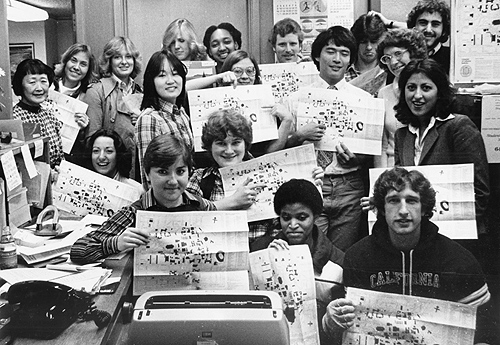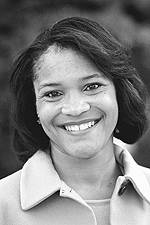Berkeleyan
 Over the last 40 years, generations of student tour guides have shared the campus, through their own eyes, with the public. Pictured here is 1980's spring semester cohort. |
Talking straight while walking backward
For four decades, student tour guides have given visitors a glimpse of campus history and traditions
![]()
| 29 September 2005
Later this week a rare breed will gather at the foot of the Campanile to celebrate and reminisce - folks who know by heart not only the number of bells in the tower's carillon but how many bones are in the Valley Life Sciences Building's T. rex, what year Doe Library was built and who it's named for, where to find the largest (and smallest) campus bear sculptures, and how many were arrested during the Free Speech Movement. The Friday event will celebrate the 40th anniversary of the campus Visitor Center and the generations of student tour guides who have shared the campus, through their own eyes, with the public.
More than 50 students, nearly all of them undergrads, currently hold the demanding but highly coveted campus job, delivering tours to nearly 40,000 visitors a year. Many of them will be on hand, mingling with Visitor Center staff and student guides from days gone by - among them Dick Hafner, former head of Public Affairs, who launched the center in 1965 (when the UC system provided tours for school groups but not the general public), and Fannie Jeffrey, who headed the Visitor Center for 20 years, beginning in 1967 with about eight student guides.
"I grew up in Berkeley and had seen its buildings all my life, but didn't have a clue" about campus history or what went on inside its classrooms, Jeffrey recalls. Under her leadership the Visitor Center (then located on the main floor of Martin Luther King, Jr. Student Union) developed tour routes still used today - at times, in those days, adjusting the route to avoid the biggest protests, she recalls. "Those were exciting for visitors," she says, "but we had to be sure that they not get caught up in it." One guide, who used a wheelchair, developed a wheelchair-accessible route for visitors with disabilities, still available today; another tour for those with mobility concerns traverses the campus on an electric cart.
Over its four decades, the Visitor Center - now located in University Hall, where its weekday tours set out - has gradually standardized and professionalized its offerings. Its annually updated staff manual (which has been evolving since Jeffrey's time) not only outlines work expectations but is chockablock with tour-delivery tips ("Remember to keep the tour as interesting as it is accurate. It makes no difference how much you know if no one is really listening."), frequently asked questions, and Cal history, traditions, facts, and statistics. Aspiring tour guides must master the handbook's contents and pass a written test. As some of Berkeley's most important ambassadors, however, they're encouraged to let their own personalities, interests, and campus experiences come through in their tours - sharing what it's like to live in a residence hall or how they deal with large lecture classes rather than snowing visitors with, as the handbook puts it, "obscure trivia."
 LaDawn Duvall |
"You can't not talk about our landmarks and achievements," says Visitor Center Director LaDawn Duvall. "And yet it's important that each tour be unique to that student." In selecting tour guides, she says, she evaluates not just their command of the facts but how they present that information: "I'm interested in their style, voice level, how well they walk backward."
"Standing up there, you've got to be able to think on your feet," says student guide Melissa Jones, who gave her first tour in summer 2004 and has "lost count" of how many tours she's conducted since. Her tour "playbook" includes, on occasion, the use of "filler facts" until the answer to a visitor's factual question rises to the surface. Inquiries are welcome, though. "I hate the groups when there's no questions. The best tours are when I get a lot of feedback."
In summer the Visitor Center attracts scores of tourists to Northern California, all wanting to see the Campanile and the birthplace of the Free Speech Movement when they reach Berkeley. Throughout the year, and especially in early spring, its 90-minute drop-in walking tours are packed with prospective students deciding where to go to college.
Parents want to know about the co-ed bathrooms in the residence halls, says Jones; students ask about specific majors and what Berkeley students do for fun. She relies a lot on humor to keep her show lively - making fun of herself as an "overachiever" as a segue into her rap on finding community at Berkeley by joining a student group. And her commentary on Nobel laureates' parking-spots-for-life and the campus's ugliest buildings, she says, "never fails to get a laugh."
The Visitor Center offers free campus tours seven days a week, as well as other tours by arrangement. For information on tours, and hours and entrance fees for the Campanile, visit www.berkeley.edu/visitors/.

